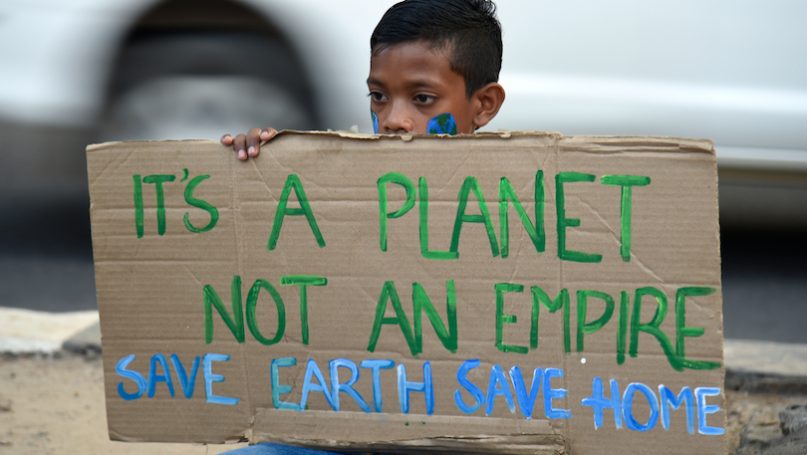
In a three-day state visit to China, US special envoy on climate change, John Kerry, labeled Climate Change as a “universal threat to humankind”; a sentiment also echoed by his Chinese counterpart, Xie Zhenhua. As these two economic giants, also the world’s largest polluters, grapple with the pressing issue of climate change, which theoretically should be a common goal, the reality tells a different story. Climate diplomacy, when entangled with the historical complexities of US-China relations, unveils a complex dynamic between these two economic giants that inevitably influences every aspect of international relations – including climate change.
Reviewing some of the recent instances when the two tried to make progress, and how this fell apart, is useful. The major breakthrough came when the United States and China joined hands at COP26 for climate cooperation talks amidst political tensions. In a groundbreaking moment, both countries issued a joint declaration acknowledging the urgency of combating climate change and pledging to intensify their efforts. China’s top climate diplomat, Xie Zhenhua, emphasized the common ground between the nations, stating, “There is more agreement between the two countries than the divergence.” Xie’s statement was followed by John Kerry’s, who, while acknowledging the differences, recognized, “on Climate, cooperation is the only way to get the job done”. However, this success was short-lived.
Nancy Pelosi’s 2022 visit to Taiwan sparked further tensions. The ensuing situation essentially brought both countries at loggerheads that resulted in the suspension of all sorts of cooperation, including climate change. Beijing’s response to severing the climate cooperation was straightforward, asserting that no aspect of the bilateral relationship can be isolated from the broader political ties. Chinese diplomat Wang Yi succinctly captured this sentiment, stating that “climate cannot be an oasis surrounded by the desert.” The relationship was dealt with another blow in February 2023 when a Chinese spy balloon was shot down over American airspace, prompting the Secretary of State Antony Blinken to cancel his planned visit to China.
As tensions between the two countries intensified, the space for climate cooperation shrunk. President Biden’s signature “Inflation Reduction Act”, enacted in August 2022, raised eyebrows in China as it was seen as a strategy to bolster the US domestic renewables industry at the expense of Chinese manufacturers. This perception further strained the diplomatic ties, leaving the climate partnership in limbo. With progress stalled on the diplomatic front, the Biden administration sought alternative ways to press China into reducing emissions, hinting it might place additional “carbon footprint-linked tariffs” on Chinese imports. This move was dubbed by the Chinese policymakers as “green trade barriers,” aimed at undermining the competitiveness of Chinese exports in international markets. Kelly Sims Gallagher, who served as a senior adviser on Chinese climate matters in the Obama administration, summarised China’s perspective by stating: “Climate is understood by China to be something the U.S. wants, and it’s using climate as a source of leverage in the multifaceted relationship.”
As the world’s two biggest powers engage in such disputes, developing countries reeling from the “climate crisis” have upped the ante, demanding the developed North to act upon a prior-outlined, yet unfulfilled, $100 billion annual commitment. In the past, both the United States and China have acknowledged their responsibilities to vulnerable developing nations. However, their actions have often fallen well short.
Under Obama, the US pledged $3 billion to the Green Climate Fund, the largest climate fund which provides funding for climate initiatives in developing countries. However, it failed to deliver on $2 billion of that promise, primarily because of the succeeding Trump adminstration’s decision to withdraw from the Paris climate accord (Biden later rejoined). Similarly, in 2015, China committed $3.1 billion to set up what it called a “South-South” climate cooperation. However, the tale of this initiative is also not quite different from that of its counterpart, having delivered only about 10 percent or $310 million of the initially pledged $3.1 billion funding.
The old African proverb “when elephants fight, it is the grass that suffers” sits rather aptly in this context as it is poorer, more climate-vulnerable, nations that are suffering in the US-China pursuit of world dominance. As the climate challenge continues to grow year-on-year, the spotlight remains overly fixed on how these two superpowers navigate the intricate path of climate cooperation while safeguarding their respective national interests.
Further Reading on E-International Relations
- Cooperation or Competition: US-China Dynamics on Climate Change
- Opinion – Washington-Baku Cooperation Towards COP29 in a Fragmented World
- With Great Power Comes Great Climate Responsibility
- Opinion – The World Bank’s Comprehensive Climate-Centric Transformation
- International Relations Theory after the Cold War: China, the Global South and Non-state Actors
- US-China Dynamics: Competition, Conflict or Cooperation?